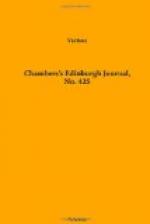At the appointed hour, three ladies were ushered into the drawing-room, bearing so startling a resemblance to each other in person, manner, and costume, that we at once decided they must be trins. Not so, however; there was a year or two’s difference in age between them, which rendered the strong resemblance more remarkable. They were tall, well-formed, plump ladies, of middle or uncertain age; with round, unmeaning faces, flaxen locks, and pale-blue eyes. There was not a perceptible thread or pucker different in their three dresses, which must have fitted all indiscriminately; the flaxen curls were arranged in precisely the same waves round each mealy countenance; and the neat caps, with bright-green ribbons, doubtless had the same exact quantity of tulle and gauze in their fashioning. Each sister owned a delicate work-basket—trinal baskets also; and in each receptacle reposed a similar square of worsted-work, the same to the last stitch. We heard the visitors named as Miss Bonderlay, Miss Paulina Bonderlay, and Miss Constantia Bonderlay; but that was of no use, since they were not ticketed, and our blunders became embarrassing and ludicrous. We addressed Miss Bonderlay as Miss Paulina, when the senior lady drew up with dignified composure, and pointing to a sister, said: ’I am Miss Bonderlay: that lady is Miss Paulina Bonderlay.’ And so on with the other two, who explained that they were juniors, as they waved a lily hand towards their eldest sister, indicative of her supremacy. But as the evening advanced, we learned to distinguish them by a peculiarity of expression, which had gained for these amiable maidens the somewhat singular cognomens of Really! Indeed! and Impossible! for their conversation, if conversation it could be called, consisted almost wholly of these interjections, pronounced in an unvarying, monotonous voice, while no shadow of emotion was perceptible on the cloudless expanse of their unwrinkled physiognomies.
When they were addressed in the usual conversational appeal which demands a reply of some kind, Miss Bonderlay, sipping her tea, or bending over her work, softly ejaculated: ‘Really!’ If you turned to Miss Paulina for some more tangible announcement of her opinion, she responded, in precisely the same tone: ‘Indeed!’ And when, as a last resource, you looked towards Miss Constantia, the word ‘Impossible!’ and that word alone, fell in honeyed accents from her ruby lips. By this means they were easily distinguished; and their most intimate friends often failed to recognise which was which when apart, and sometimes even when they were together, until the talismanic syllables gave to each her individuality. The peculiarity gave rise to a little good-humoured ridicule; but for our part, we thought it quite wonderful how well they played their part in conversation with so small a stock of words. There is much pliability of meaning, however, in an interjection; and in company, where there are




